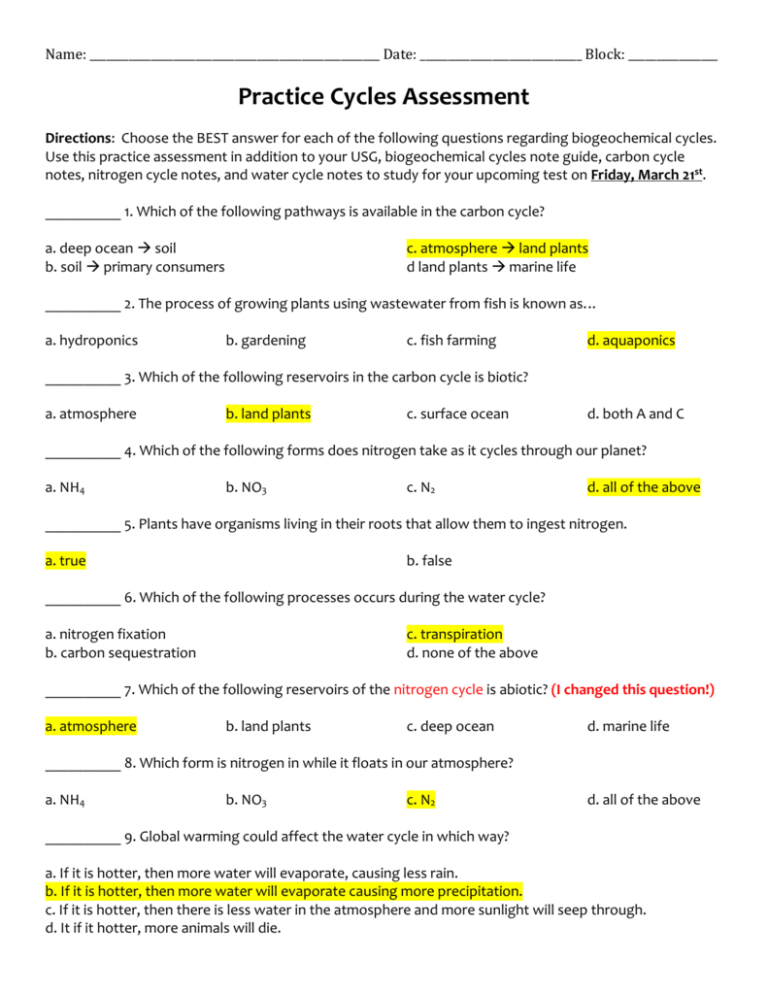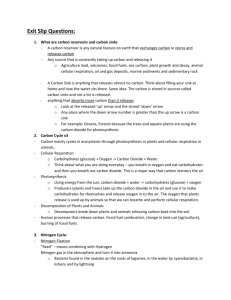cycles practice test ANSWERS
advertisement

Name: ____________________________________________________ Date: _____________________________ Block: ________________ Practice Cycles Assessment Directions: Choose the BEST answer for each of the following questions regarding biogeochemical cycles. Use this practice assessment in addition to your USG, biogeochemical cycles note guide, carbon cycle notes, nitrogen cycle notes, and water cycle notes to study for your upcoming test on Friday, March 21st. __________ 1. Which of the following pathways is available in the carbon cycle? a. deep ocean soil b. soil primary consumers c. atmosphere land plants d land plants marine life __________ 2. The process of growing plants using wastewater from fish is known as… a. hydroponics b. gardening c. fish farming d. aquaponics __________ 3. Which of the following reservoirs in the carbon cycle is biotic? a. atmosphere b. land plants c. surface ocean d. both A and C __________ 4. Which of the following forms does nitrogen take as it cycles through our planet? a. NH4 b. NO3 c. N2 d. all of the above __________ 5. Plants have organisms living in their roots that allow them to ingest nitrogen. a. true b. false __________ 6. Which of the following processes occurs during the water cycle? a. nitrogen fixation b. carbon sequestration c. transpiration d. none of the above __________ 7. Which of the following reservoirs of the nitrogen cycle is abiotic? (I changed this question!) a. atmosphere b. land plants c. deep ocean d. marine life __________ 8. Which form is nitrogen in while it floats in our atmosphere? a. NH4 b. NO3 c. N2 d. all of the above __________ 9. Global warming could affect the water cycle in which way? a. If it is hotter, then more water will evaporate, causing less rain. b. If it is hotter, then more water will evaporate causing more precipitation. c. If it is hotter, then there is less water in the atmosphere and more sunlight will seep through. d. It if it hotter, more animals will die. __________ 10. Which of the following does NOT occur in ecosystems? a. Energy flows through the system. b. Nitrogen is cycled between biotic and abiotic forms. c. Producers convert light energy to chemical energy. d. The light source that powers the system is used by consumers to make organic compounds. __________ 11. Given that CO2 is produced by cellular respiration, why does the amount of CO2 in the atmosphere remain relatively constant? (When answering this question, exclude the impact of human industrial activities on atmospheric CO2.) a. Carbon dioxide is consumed by photosynthesis to produce carbohydrates. b. Carbon dioxide is consumed by decomposers. c. Carbon dioxide mostly forms rocks. d. Carbon dioxide is trapped in dead organisms’ bodies. __________ 12. Denitrifying bacteria convert ______ to _______. a. ammonium…nitrates b. atmospheric nitrogen gas…nitrates c. nitrates... atmospheric nitrogen gas d. atmospheric nitrogen gas… nitrites __________ 13. Nitrogen is needed to synthesize… a. amino acids b. DNA c. proteins d. all of the above __________ 14. Farmers often include legumes as part of their normal crop rotation. This increases the overall production of their crops by… a. adding nitrogen to the soil. b. adding phosphorus to the soil. c. helping the soil retain water better. d. increasing the plants’ rate of photosynthesis. __________ 15. A student wanted to design an experiment to determine the effect of nitrate son algae growth. Which procedure would create the most valid results? a. Vary both the temperature and the amount of nitrates. b. Keep the temperature constant and vary the amount of nitrates. c. Vary the temperature and keep the amount of nitrates constant. d. Keep both the temperature and the amount of nitrates constant. __________ 16. In a hypothetical food chain consisting of grass, grasshoppers, sparrows, and hawks, the grasshoppers are ________________________________. a. primary consumers. b. primary producers. c. secondary consumers. d. secondary producers. __________ 17. Evaporation, condensation, and precipitation are part of… a. the water cycle b. transpiration c. the carbon cycle d. the lithosphere __________ 18. Which of the following describes the process of water changing from a gas to a liquid to form clouds? a. precipitation b. evaporation c. condensation d. infiltration __________ 19. Plants capture and transfer solar energy in a process called… a. ecology b. solar conversion c. photosynthesis d. cellular respiration __________ 20. Which of the following is a reactant for cellular respiration? a. CO2 b. C6H12O6 c. Energy d. H2O __________ 21. Which is the following is a product of photosynthesis? a. CO2 b. C6H12O6 c. Energy d. H2O __________ 22. What is the most abundant gas in the atmosphere? a. oxygen b. nitrogen c. carbon d. hydrogen __________ 23. An example of a detritus feeder is… a. a deer b. a photosynthetic bacterium c. an earthworm d. a rabbit __________ 24. Inorganic nutrients are released from dead organic matter and animal waste by… a. decomposers b. secondary consumers c. producers d. autotrophs __________ 25. Which of the following nutrients can be a limiting nutrient because of plants' inability to use its gaseous form? a. nitrogen b. phosphorus c. hydrogen d. carbon __________ 26. As written the below chemical process occurs in which of the following? 6CO2 + 12H2O + RADIANT ENERGY ---> C6H12O6 + 6H2O + 6O2 a. consumers b. decomposers c. producers d. scavengers Practice Free Response Questions 1. Using the image of the nitrogen cycle below, label which process is taking place at each letter. A: Denitrification B: Eating (primary consumer) C: Nitrification D: Nitrogen Fixation 2. Using the image of he carbon cycle below, identify what is at each letter. A: Atmosphere (CO2) A E B B: Cellular Respiration C C: Photosynthesis D: Decomposers E: Burning of fossil fuels D 3. Using your knowledge of the carbon and nitrogen cycle, complete the chart below. Carbon Nitrogen Largest abiotic reservoir Ocean Atmosphere Chemical form in abiotic reservoir Carbonic Acid (You do not need to know this!) Nitrogen Gas (N2) From used by producers Carbon Dioxide (CO2) as a reactant of photosynthesis Nitrates (NO3-) and Ammonium (NH4+) which are taken up via assimilation. Burning fossil fuels (combustion reaction releases carbon dioxide into the atmosphere). Adding fertilizer to farms and lawns which runs off in to lakes and rivers (more on this to come). Human activities that alter the cycle Deforestation (taking away the reservoir that takes in carbon dioxide). 4. Define each process in the water cycle (hydrologic cycle). a. Precipitation: water falls from the clouds in the form of rain, snow, sleet, or hail based on temperature b. Transpiration: plants “sweating” through their leaves (water going back to the atmosphere) c. Evaporation: water changing phase from a liquid to a gas (water vapor) d. Runoff: water moving across the lithosphere (land) e. Condensation: water changing phase from a gas to a liquid (how clouds are formed) f. Infiltration: water seeping through the rocks and gravel into the groundwater supply g. Radiation: form of heat transfer from the sun that causes evaporation h. Aquifer/Groundwater: water supply underground that feeds lakes and rivers









